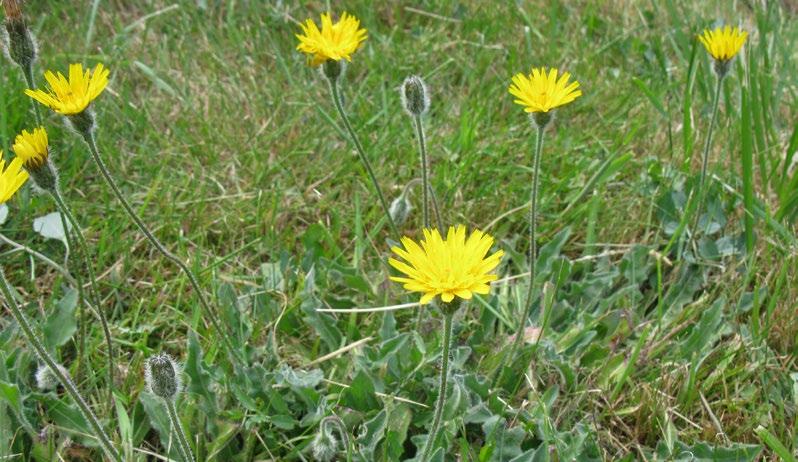
4 minute read
Hazel Metherell
BEGINNER’S CORNER
When is a Dandelion not a Dandelion? (A beginner’s guide to yellow composites)
Advertisement
HAZEL METHERELL
Rough Hawkbit (Leontodon hispidus). Debbie Allan
In summer there appear lots of dandelion-ish looking flowers, but they are often not. The heads consist of many individual flowers called ‘florets’, the outer ones usually each with one long yellow ‘ray.’ I am not covering flowers with much smaller heads, like Prickly Lettuce (Lactuca serriola), Nipplewort (Lapsana communis) or Wall Lettuce (Mycelis muralis), or anything rare enough not to come across it accidentally. And we’re certainly not going to delve into Hawkweeds (Hieracia) at this stage!
If the plant has long raggedly-lobed leaves in a ground-level rosette, with bare unbranched stems (oozing latex when snapped) and a single densely packed head of yellow florets… you have the real thing: Taraxacum agg., a Dandelion. There are over 250 species. Let’s not go there for now! But if you want a taste see bsbi.org/identification/taraxacum.
Let’s start with an easy one! Mouse-ear Hawkweed (Pilosella officinarum). The flowers are generally a more lemon shade than the other options; a single head on an unbranched stem. You can soon spot them at a distance. The leaves have long white hairs, each about 10mm long. Pilus is Latin for hair, so Pilosella is very appropriate.
No long white hairs? Then look at the bracts (‘phyllaries’) encircling the green part of the flowerhead. Hawk’s-beards (Crepis) have an inner set of bracts clasping the flower bases like a cup, and an outer set of smaller bracts spreading outwards like a saucer. The most common ones are Smooth Hawk’sbeard (C. capillaris), which is usually hairless and Beaked Hawk’s-beard (C. vesicaria) which is usually downy. Both usually have multiple (i.e. branched) flowerheads. Unfortunately the only reliable way to tell them apart is by looking at the little parachute fruits. In Beaked Hawk’s-beard the seed is drawn out into a long tip, like a long beak, with the parachute hairs at the top. In Smooth Hawk’s-beard the seed is courgette-shaped with the hairs on the end, without a beak. Sounds tricky, but they are very distinct.
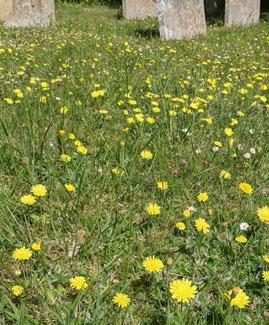
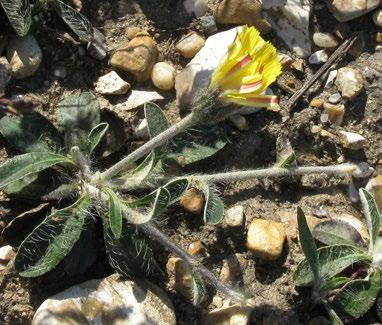
Lemon yellow flowers of Mouse-ear Hawkweed (Pilosella officinarum) (left). John Norton. Close up of a plant showing the long white hairs on leaves (right). All other photographs by Debbie Allan.
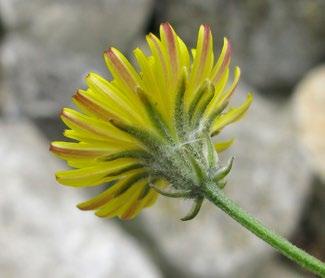
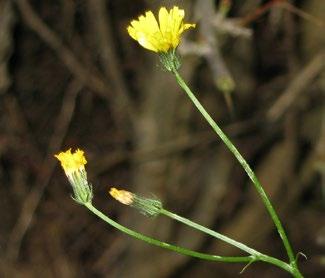
Beaked hawk’s-beard (Crepis vesicaria) (left) and Smooth Hawk’s-beard (C. capillaris) (right), showing branched inflorescence and ‘cup and saucer’ phyllaries.
No outer set of bracts? Then consider Hawkbits next (why do they give groups such similar and unhelpful English names?). Hawkbits (Leontodon) have a basal rosette of leaves and one or two flowers on leafless stems. Flowerheads are 25–40mm diameter. Look at the leaves. If they have forked hairs, like a tiny ‘letter Y’ then you have a Hawkbit. There are two common ones: Rough Hawkbit (L. hispidus) and Lesser Hawkbit (L saxatilis), usually with a single flowerhead on each stem, and again the only reliable way to tell them apart is by looking at the fruits. Rough Hawkbit has the usual long white hairs on the top of all the fruits. In Lesser Hawkbit the hairs are missing from the outermost ring of fruits. In general, the flowerheads and leaves of Rough Hawkbit are larger than Lesser Hawkbit, and the stem is hairier. Just unforked ‘simple’ hairs? Now you need to resort to surgery! Both of the following usually have multiple flowerheads. The key character is that if you pull the head apart, and there are papery scales
between the florets you have a Cat’s-ear (Hypochaeris). They also usually have characteristic little leafy scales up the stem… the cat’s ears? There is one common species H. radicata, just called ‘Cat’s-ear’; but if you see one with dark blotches on the leaves don’t pick it – it might be the rare Spotted Cat’s-ear (H. maculata). Also look out for Smooth Cat’s-ear (H. glabra) an uncommon species of acid grassland with tiny flowerheads about 1cm across.
No papery scales? Then it’s probably Autumn Hawkbit (this was previously Leontodon autumnalis, but has been moved to a new genus to become Scorzoneroides autumnalis). It’s generally less hairy with a few unforked hairs on the underside of the leaves, and a tapering from stem to flower base. The outer florets are reddish underneath.
Finally I’ll go through the Sow-thistles (Sonchus) because they’re obvious and three are common. These are often large, stately plants with several flowers, each on a stem branching from the same point (an ‘umbel’, like an umbrella) and jagged leaves which clasp the stem. They have latex in the stems like Dandelions. Perennial Sow-thistle (S. arvensis), is worth looking at under a hand lens to see what the books mean by ‘glandular hairs’. The stems and green bracts under the flowerhead are covered in hairs with sticky yellow blobs on the tip of each. The leaf bases are V-shaped, ‘clasping’ the stem on both sides. Smooth Sow-thistle (S. oleraceus). Guess what? No hairs, glandular or otherwise! Leaf bases are similar to S. arvensis. Prickly Sow-thistle (S. asper). Yes, you’ve got it, there is no missing the prickly leaves that curl up and under on each side of the stem.
Hazel Metherell
hazelmetherell@gmail.com
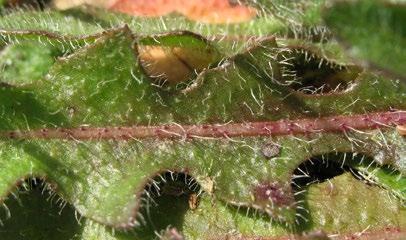
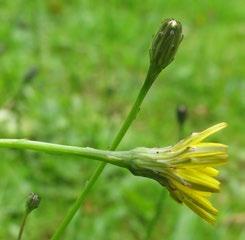
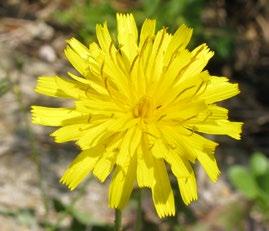
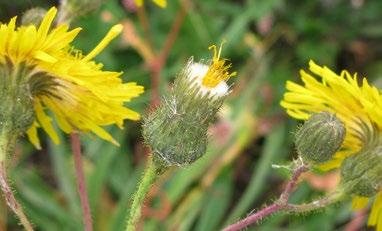
Left to right, top to bottom: Leaf of Lesser Hawkbit (Leontodon saxatilis) showing forked hairs; Cat’s-ear (Hypochaeris radicata) with scales on the flower stalk; Autumn Hawkbit (Scorzoneroides autumnalis) looking very much like a dandelion; Perennial Sow-thistle (Sonchus arvensis) showing the yellow glands.









